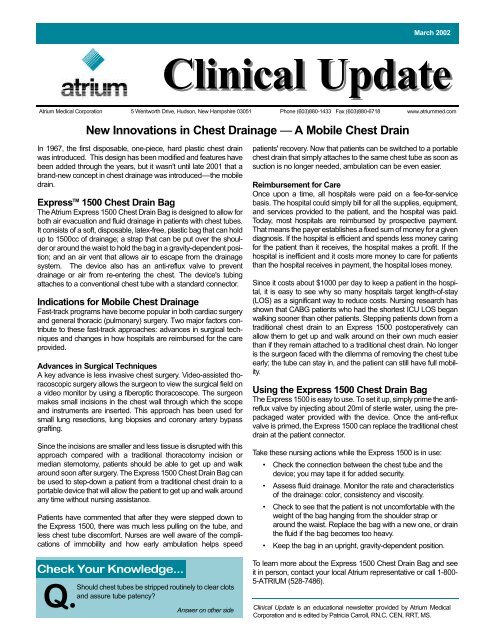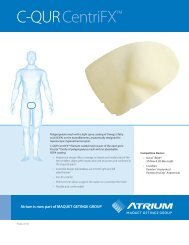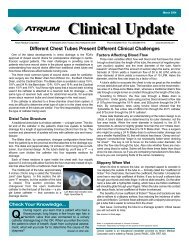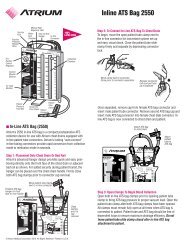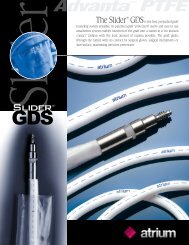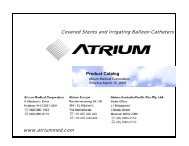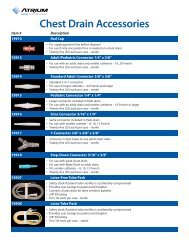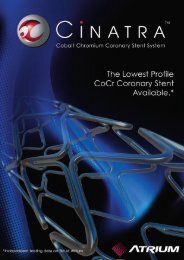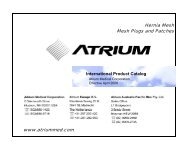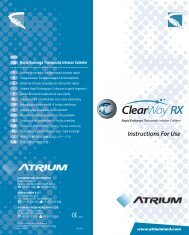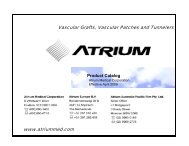New Innovations In Chest Drainage - Atrium Medical Corporation
New Innovations In Chest Drainage - Atrium Medical Corporation
New Innovations In Chest Drainage - Atrium Medical Corporation
Create successful ePaper yourself
Turn your PDF publications into a flip-book with our unique Google optimized e-Paper software.
March 2002Clinical Update<strong>Atrium</strong> <strong>Medical</strong> <strong>Corporation</strong> 5 Wentworth Drive, Hudson, <strong>New</strong> Hampshire 03051 Phone (603)880-1433 Fax (603)880-6718 www.atriummed.com<strong>New</strong> <strong><strong>In</strong>novations</strong> in <strong>Chest</strong> <strong>Drainage</strong> — A Mobile <strong>Chest</strong> Drain<strong>In</strong> 1967, the first disposable, one-piece, hard plastic chest drainwas introduced. This design has been modified and features havebeen added through the years, but it wasn't until late 2001 that abrand-new concept in chest drainage was introduced—the mobiledrain.Express TM 1500 <strong>Chest</strong> Drain BagThe <strong>Atrium</strong> Express 1500 <strong>Chest</strong> Drain Bag is designed to allow forboth air evacuation and fluid drainage in patients with chest tubes.It consists of a soft, disposable, latex-free, plastic bag that can holdup to 1500cc of drainage; a strap that can be put over the shoulderor around the waist to hold the bag in a gravity-dependent position;and an air vent that allows air to escape from the drainagesystem. The device also has an anti-reflux valve to preventdrainage or air from re-entering the chest. The device's tubingattaches to a conventional chest tube with a standard connector.<strong>In</strong>dications for Mobile <strong>Chest</strong> <strong>Drainage</strong>Fast-track programs have become popular in both cardiac surgeryand general thoracic (pulmonary) surgery. Two major factors contributeto these fast-track approaches: advances in surgical techniquesand changes in how hospitals are reimbursed for the careprovided.Advances in Surgical TechniquesA key advance is less invasive chest surgery. Video-assisted thoracoscopicsurgery allows the surgeon to view the surgical field ona video monitor by using a fiberoptic thoracoscope. The surgeonmakes small incisions in the chest wall through which the scopeand instruments are inserted. This approach has been used forsmall lung resections, lung biopsies and coronary artery bypassgrafting.Since the incisions are smaller and less tissue is disrupted with thisapproach compared with a traditional thoracotomy incision ormedian sternotomy, patients should be able to get up and walkaround soon after surgery. The Express 1500 <strong>Chest</strong> Drain Bag canbe used to step-down a patient from a traditional chest drain to aportable device that will allow the patient to get up and walk aroundany time without nursing assistance.Patients have commented that after they were stepped down tothe Express 1500, there was much less pulling on the tube, andless chest tube discomfort. Nurses are well aware of the complicationsof immobility and how early ambulation helps speedCheck Your Knowledge...chest tubes be stripped routinely to clear clotsand assure tube patency?Q.ShouldAnswer on other sidepatients' recovery. Now that patients can be switched to a portablechest drain that simply attaches to the same chest tube as soon assuction is no longer needed, ambulation can be even easier.Reimbursement for CareOnce upon a time, all hospitals were paid on a fee-for-servicebasis. The hospital could simply bill for all the supplies, equipment,and services provided to the patient, and the hospital was paid.Today, most hospitals are reimbursed by prospective payment.That means the payer establishes a fixed sum of money for a givendiagnosis. If the hospital is efficient and spends less money caringfor the patient than it receives, the hospital makes a profit. If thehospital is inefficient and it costs more money to care for patientsthan the hospital receives in payment, the hospital loses money.Since it costs about $1000 per day to keep a patient in the hospital,it is easy to see why so many hospitals target length-of-stay(LOS) as a significant way to reduce costs. Nursing research hasshown that CABG patients who had the shortest ICU LOS beganwalking sooner than other patients. Stepping patients down from atraditional chest drain to an Express 1500 postoperatively canallow them to get up and walk around on their own much easierthan if they remain attached to a traditional chest drain. No longeris the surgeon faced with the dilemma of removing the chest tubeearly; the tube can stay in, and the patient can still have full mobility.Using the Express 1500 <strong>Chest</strong> Drain BagThe Express 1500 is easy to use. To set it up, simply prime the antirefluxvalve by injecting about 20ml of sterile water, using the prepackagedwater provided with the device. Once the anti-refluxvalve is primed, the Express 1500 can replace the traditional chestdrain at the patient connector.Take these nursing actions while the Express 1500 is in use:• Check the connection between the chest tube and thedevice; you may tape it for added security.• Assess fluid drainage. Monitor the rate and characteristicsof the drainage: color, consistency and viscosity.• Check to see that the patient is not uncomfortable with theweight of the bag hanging from the shoulder strap oraround the waist. Replace the bag with a new one, or drainthe fluid if the bag becomes too heavy.• Keep the bag in an upright, gravity-dependent position.To learn more about the Express 1500 <strong>Chest</strong> Drain Bag and seeit in person, contact your local <strong>Atrium</strong> representative or call 1-800-5-ATRIUM (528-7486).Clinical Update is an educational newsletter provided by <strong>Atrium</strong> <strong>Medical</strong><strong>Corporation</strong> and is edited by Patricia Carroll, RN,C, CEN, RRT, MS.
Clinical Update for the Professional Nurse March 2002<strong>In</strong> The LiteratureUsing Non-Credentialed PersonnelAppropriatelyMost nurses have seen an increase in the use of assistive personnel inthe nursing department. While many authors use the term "unlicensedassistive personnel," I prefer to use the term "non-credentialed assistivepersonnel" (NCAP) because we have colleagues who have a professionaldegree and a national credential, but may not have a statelicense. That said, a recent article by Valerie Kido in NursingManagement provides guidance on how to use assistive personnelproperly and strive for high quality patient care. The key to proper useof NCAP is understanding that the registered nurse has the responsibilityand accountability to delegate or not to delegate patient care activities.The nurse cannot delegate simply according to task; rather, thedelegation must be individualized to the patient. Let's say, for example,two men share a room. Both require feeding. Patient one needs to befed because he burned his hands in an accident and is unable to usehis hands to feed himself. Patient two needs to be fed because he hada stroke and has hemiparesis. Are these feedings equivalent? RNsshould not delegate "all feedings," but should individualize the delegationbased on the complexity of the task, the potential for harm, the abilitiesof the worker, and the necessary problem-solving skills. This articleprovides a quick overview of the key aspects of using assistive personnelappropriately.Source: Kido V: The UAP dilemma. Nursing Management 2001;32(11):27-29.Ethical Issues and the Nursing ShortageThis article, written by Dr. Judith Erlen, a nurse who is also acting codirectorof research at the Center for Bioethics and Health Law at theUniversity of Pittsburgh, examines ethical issues many nurses arestruggling with during the current nursing shortage. She notes thatnurses are trying to reconcile how to fulfill their duties as patient advocatesand to warn patients about conditions that may be detrimental totheir well-being.Dr. Erlen focuses on two aspects of nursing that present pressing ethicalissues for practicing nurses: a lack of control over their practice andthe potential of harming patients. The lack of control stems from anadministrative shift resulting in a structure in which decisions that wereonce nursing decisions about self-determination are now made for us— without our input in many cases. <strong>In</strong> addition, nurses are not beingtreated with respect as the professionals we are. The potential for harmcomes from unreasonable nurse:patient ratios, inappropriate use ofassistive personnel, and the feeling that the nurse just can't keep upand may miss a key patient assessment due to overwork.After identifying the problems, Dr. Erlen provides a number of strategiesnurses may wish to try to help resolve ethical issues presented by thecurrent nursing shortage. This thought-provoking article is worth a lookto understand the ethical dilemmas that nurses at the bedside may noteven be able to articulate, but that result in a constant level of stress innursing practice today.Source: Erlen JA: The nursing shortage, patient care and ethics. Orthopaedic Nursing2001;20(6):61-65.References: <strong>New</strong> <strong><strong>In</strong>novations</strong> <strong>In</strong> <strong>Chest</strong> <strong>Drainage</strong> - A Mobile <strong>Chest</strong> DrainAnderson B, Higgins L, Rozmus C: Critical pathways: application to selected patient outcomesfollowing coronary artery bypass graft. Applied Nursing Research 1999;12(4):168-174.Cerfolio RJ, Pickens A, et al. Fast-tracking pulmonary resections. Journal of Thoracic andCardiovascular Surgery 2001;122(2):318-324.Schwago T: Thoracoscopic surgery: a new approach to pulmonary disease. Critical CareNurse 1996;16(2):76-82.US Census Bureau, Statistical Abstract of the United States: 2000. (120th edition) Washington,DC. Table 195. Average Cost to Community Hospitals Per Patient.On theWorld WideWeb...A tip of the hat to a new nursing recruitment Web site,http://www.discovernursing.com. Many of us were astonishedto see advertisements for this site during the opening ceremoniesof the Winter Olympics — most of us can't remember when a positivemessage about nursing got such high profile exposure. Thesite is well-designed, easily navigated, and effectively communicatesthat a nursing career can be as varied as the people who arenurses.The eMedicine site is handy when you want quick access to a reliablereview of an emergency medicine topic. I have used it as aresource for many projects, and for my clinical practice. Theentries are fully searchable and are regularly reviewed for accuracy.<strong>In</strong> addition, the eMedicine folks have made a number ofdownloads available for PDA.Visit them at http://www.emedicine.comAre you looking for that acetaminophen toxicity nomogram?Need that body mass index calculator? Need to compute anAPACHE II score? Then the National Center for EmergencyMedicine <strong>In</strong>formatics Web site is for you. This site is chock-fullof useful tips, formulas, calculators, and a wealth of links to themedical literature and e- textbooks. And if you have a PDA,downloads are available for you, too. Visit them athttp://www.ncemi.orgCheck Your Knowledge...tube stripping should not be performed routinely.Nursing research has demonstrated that stripping canA.<strong>Chest</strong>generate intrapleural pressures as high as -400cmH 2 O(the amount of vacuum typically set on the drain is -20cmH 2 O). <strong>In</strong>addition, nursing research that compared stripping to straight gravitydrainage found no advantage to chest tube stripping.References: <strong>Chest</strong> Tube StrippingDuncan C, Erickson R: Pressures associated with chest tube stripping. Heart & Lung1992;11(2):166-171.Duncan CR, RS Erickson, RM Weigel: Effect of chest tube management on drainage aftercardiac surgery. Heart & Lung 1987;16(1):1-9.Gordon P, Norton JM: Managing chest tubes: what is based on research and what is not?Dimensions of Critical Care Nursing 1995;14(1):14-16.Gordon P, Norton JM, Merrel R: Refining chest tube management: analysis of the state ofpractice. Dimensions of Critical Care Nursing 1995;14(1):6- 13.Gross, SB: Current challenges, concepts and controversies in chest tube management.AACN Clinical Issues in Critical Care 1993;4(2):260-275.Isaacson JJ, LT George, MJ Brewer: The effect of chest tube manipulation on mediastinaldrainage. Heart & Lung 1986;15(6):601-605.Lim-Levy F, SA Babler, J DeGroot-Kosolcharoen et al: Is milking and stripping chest tubesreally necessary? Annals of Thoracic Surgery 1986;42(1):77-80.Oakes LL, Hinds P, Rao B et al: <strong>Chest</strong> tube stripping in pediatric oncology patients: anexperimental study. American Journal of Critical Care 1993;2(4):293-301.Pierce JD, Naftel DC: Effects of two chest tube clearance protocols on drainage in patientsafter myocardial revascularization surgery. Heart & Lung 1991;20(2):125-130.Teplitz L: Update: Are milking and stripping chest tubes really necessary? Focus on CriticalCare 1991;18(6):506-511.


